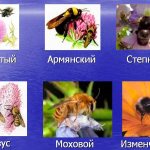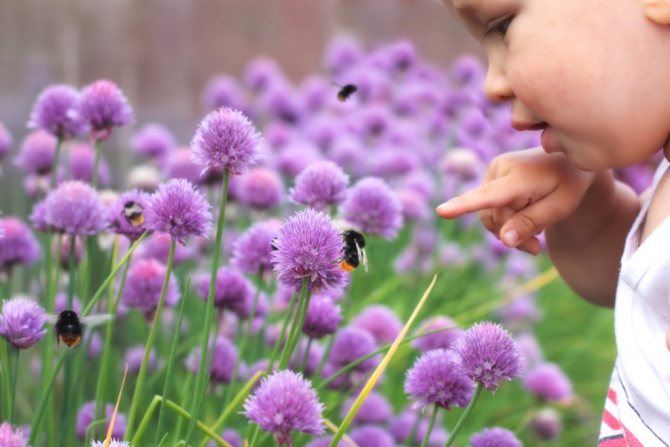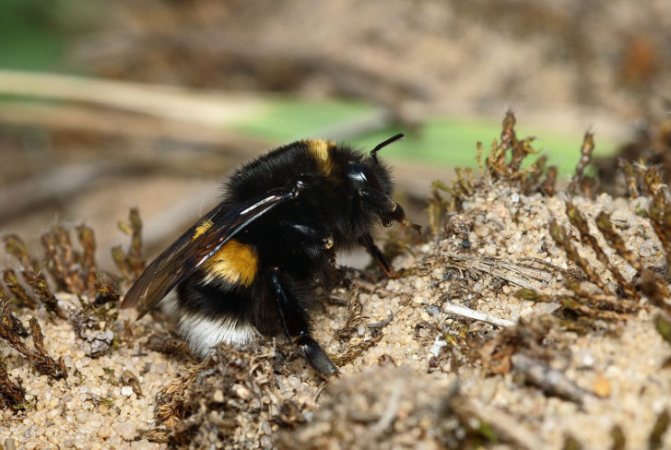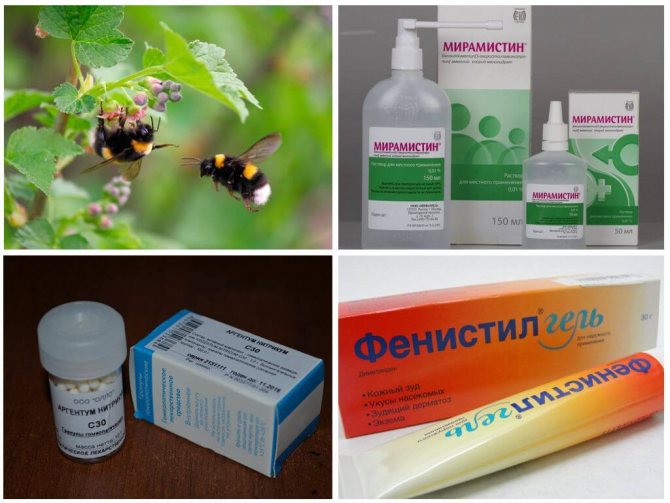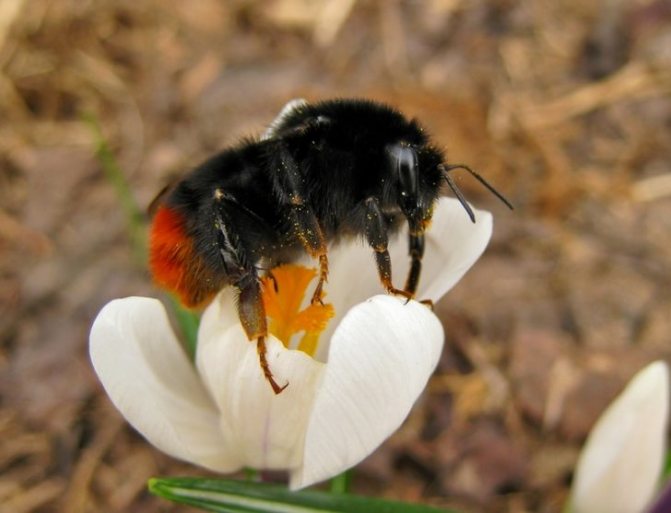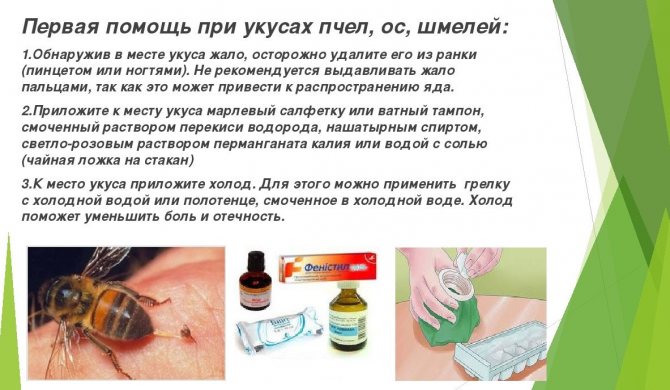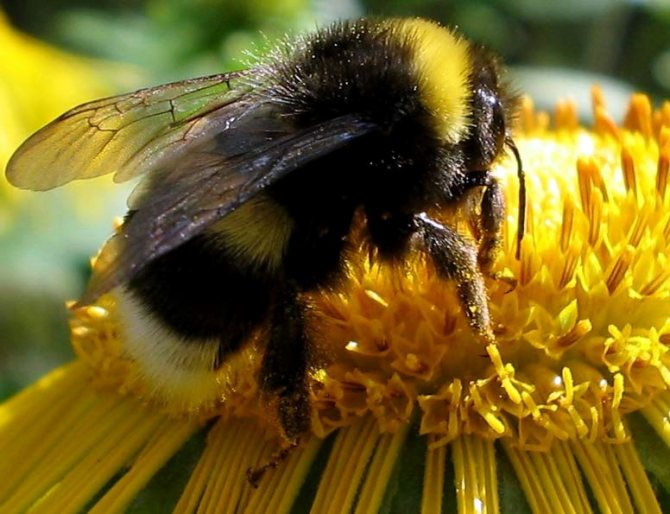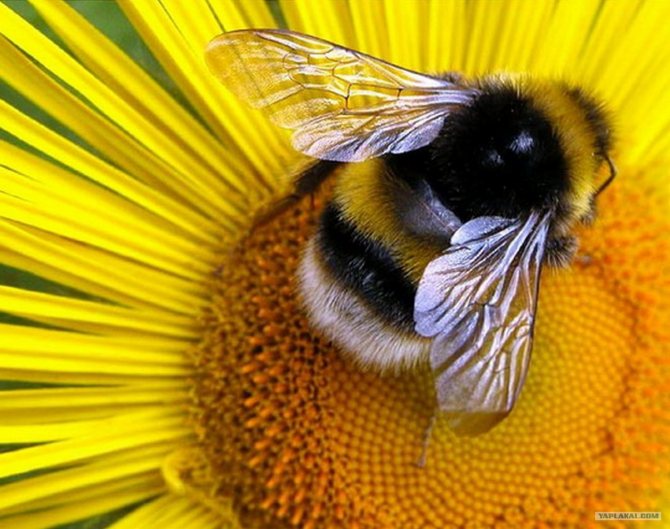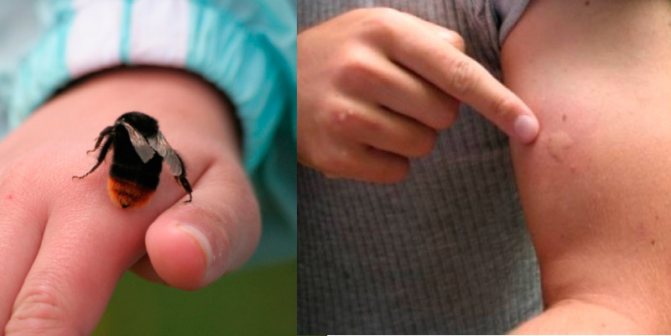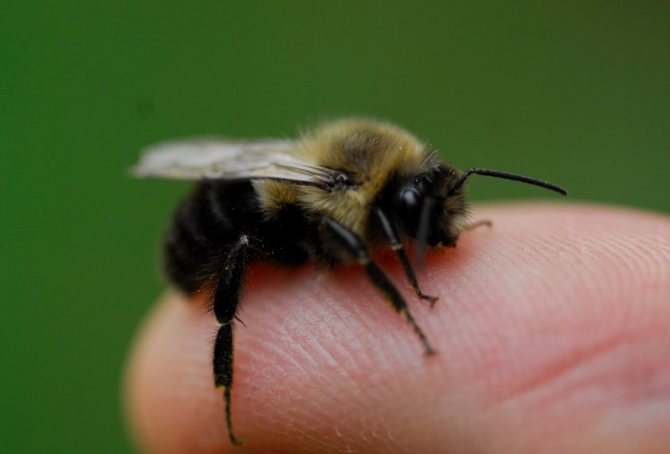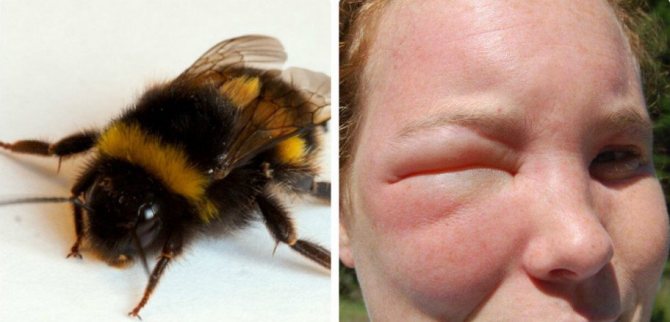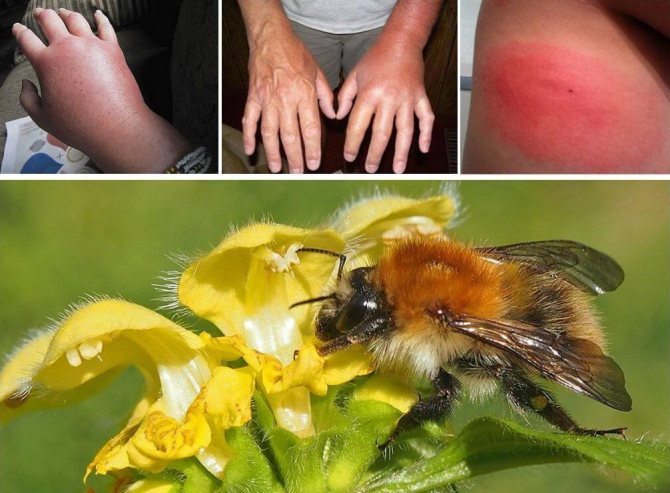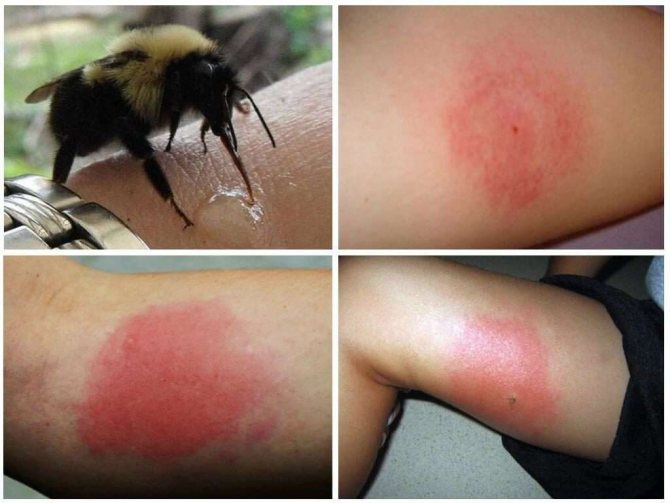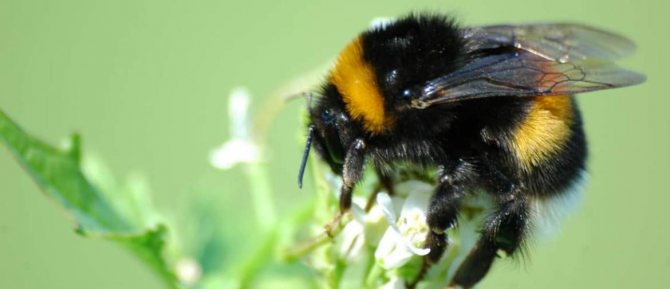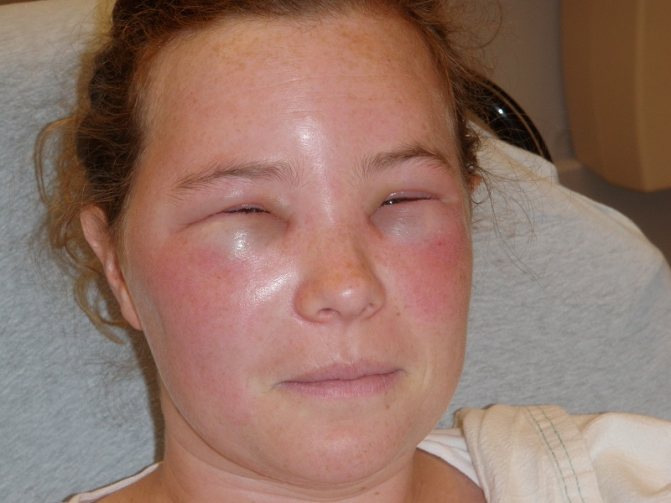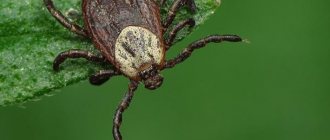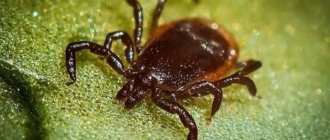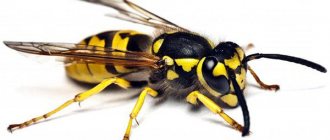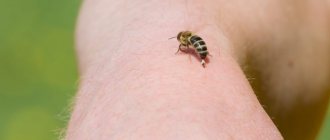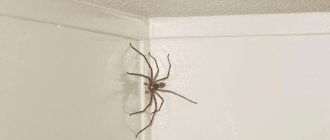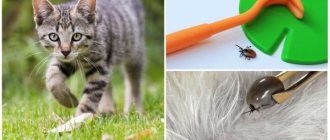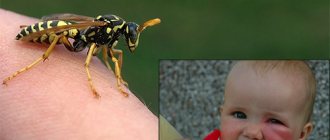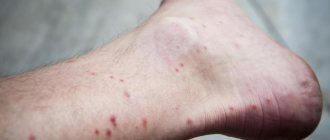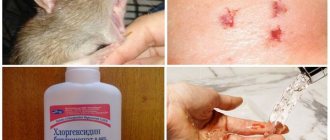Bumblebee species and their bites

Bumblebees have at least 300 species and represent a family of bees. Like bees, bumblebees are social insects, so they live in colonies. They are engaged in collecting nectar from flowers, actively pollinating plants.
The most common species that are found on our territory include:
- Purple bumblebee, who is also called "carpenter". The body of this insect is black, and the wings are purple-blue. The wingspan reaches 3 cm. The species is not aggressive, but its bite is quite unpleasant.
- Stone bumblebeesgrowing in length up to almost 30 mm. The body of the insect is covered with black bristles. It differs in that it has a red abdomen. They prefer to live in numerous colonies. The bite of this insect can cause an allergic reaction, although it is quite rare.
- Ground bumblebeewho prefers to live in the ground. To do this, he uses empty mouse holes. They grow in length up to 27 mm. The body of the earthen bumblebee is black with yellow bristles, as well as yellow stripes on the chest. Females are somewhat larger than males, while they are armed with a sting. They bite on rare occasions.
- Garden bumblebee, which is not large (only 15-23 mm) in size. The abdomen is yellow, with black setae located in the middle between the wings. Garden bumblebees live in the hollows of various trees, in rotten stumps, as well as in the ground, looking for cracks.
It should also be noted that there are field and city bumblebees.
An important point! Each colony of bumblebees has an average of 150 individuals. Locating the colony is not easy, as the nest is guarded and carefully camouflaged.
Who are bumblebees: structure, life cycle and differences from bees
These representatives of the family of real bees belong to the order of Hymenoptera. There are about 300 varieties of them in the world. The most common types of bumblebees: purple (carpenter), stone, garden, earthen. They come in medium to large sizes. The female grows in length to 13–28 mm, the male is smaller - 7–24 mm.
The most common color of bumblebees is yellow and black stripes. Individuals with red and orange stripes are also found. Some of the insects are black and devoid of stripes. The color of bumblebees is presumably due to mimicry and thermoregulation.
The female's head is elongated with a wide rounding in the occipital region. The upper lip has the shape of a rectangle, the mandibles are strongly curved, they overlap when approaching. There are 3 convex grooves on their outer surface. The belly is not bent at the apex; there are no ridges on the sides of the sixth abdominal sternitis (the abdominal part of the segmental ring). Outside, the hind tibia, shiny and smooth, form a basket for collecting pollen. It looks like a platform surrounded by tough, straight hairs.
Bumblebee sting


As mentioned above, the sting is present exclusively in females, as well as in the uterus. Compared to a bee sting, the sting of a bumblebee has no notches, so after the bite the sting does not remain in the victim's body.
The design of the sting is such that a channel is formed inside it, through which, during a bite, an insect injects poison, which consists of fats and proteins, peptides, amino acids, as well as aliphatic compounds.
Interesting to know! Compared to a bee, which dies after being bitten, a bumblebee, having bitten 1 time, is able to bite again, since it does not leave a sting, which means it does not die.
Flight features
It is often said that bumblebees violate the laws of aerodynamics and should not fly. However, recent research has solved the mystery and showed how tiny wings keep them in the air.
A study published in the journal Proceedings of the National Academy of Sciences in 2005 uses high-speed photography to show that bumblebees flap their wings back and forth rather than up and down.
The wing looks a bit like the back of a "slightly cheesy" helicopter propeller, said researcher Michael Dickinson, professor of biology. However, the angle of the wing creates vortices in the air - like small hurricanes. These mini-hurricanes have a lower pressure than the surrounding air, so keeping these air swirls above the wings helps them stay airborne.
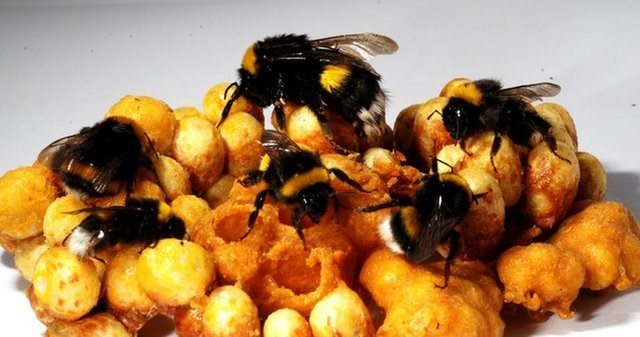

Danger of a bumblebee bite
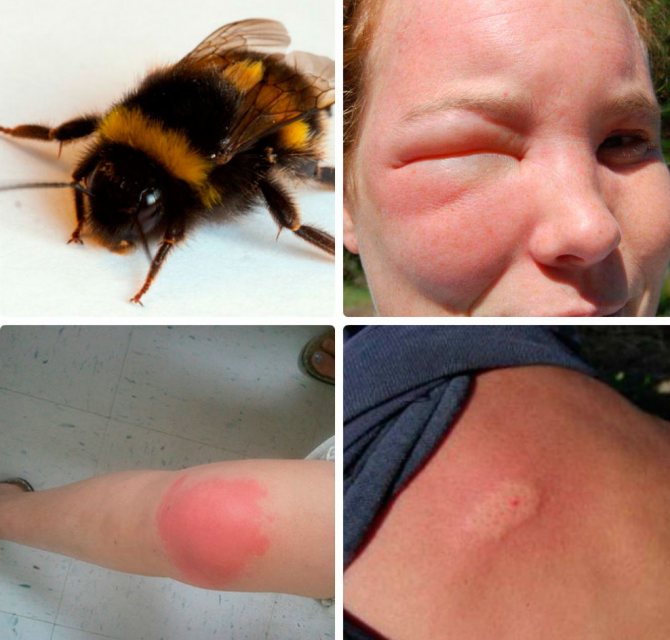

As a rule, a bumblebee bite does not pose any danger to humans, with the exception of those people who are prone to allergies.
An important fact! In the event of a second bite, the likelihood of an allergic reaction is much higher, since toxins that neutralize the insect's poison begin to be produced in the human body.
The bumblebee bite poses a certain danger to expectant mothers and lactating women, as well as children whose immune system has not yet been strengthened. Bites on the face (eyes, nose), as well as on the neck or ear will not pass without leaving a trace. As a result of the action of the poison, edema may appear, which will make it impossible for the normal functioning of these organs.
In the case of a bite in the leg or arm, if the sting did not enter the blood vessel, there are no negative manifestations. The appearance of edema is associated with the individual characteristics of the body.
The most common bumblebees bite:
- In the hand or in the finger when a person waves off bumblebees.
- In the leg when a person accidentally steps on a bumblebee feeding on the nectar of flowers.
Complications and consequences
Negative consequences after a single bumblebee bite are rare. The danger is represented by acute allergic reactions, which turn into anaphylactic shock. If a person has heart disease, then complications of the bite cannot be avoided. These can be pressure surges, angina pectoris, arrhythmias and other conditions that damage health.
The bites are also dangerous for pregnant women. Among the possible consequences are bleeding, termination of pregnancy, fetal freezing.
The risk of stinging is determined by the damaged area. The closer the bite is to the head or heart, the more terrible its consequences.
Why bumblebees bite people
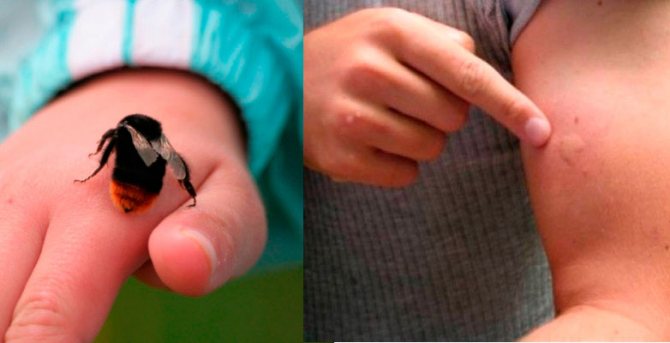

Bumblebees, in comparison with bees, are more peaceful in nature and bite only on rare occasions, for the purpose of self-defense or in order to protect the whole colony.
The insect can attack a person in other cases. For example:
- In the presence of a sharp aroma of perfumery, the smell of alcohol (fume), oxidizing metal.
- In the case of a predominance of blue in clothes, as well as in the case of sudden movements, which definitely provokes insect aggression.
Important to remember! The more insect bites, the more dangerous they are for humans, since a high level of toxins in the body can lead to disruptions in the work of many organs, including the nervous and cardiovascular systems, as well as the respiratory system. In this case, death is possible as a result of cardiac arrest or paralysis of the respiratory system.
Bumblebee bite prevention measures
it is very rare to adhere to simple recommendations:
- do not intentionally touch the insect;
- without proper ammunition, do not go to the apiary or other places where there is a lot of nectar or honey;
- refrain from eating and preparing food on the street;
- in the season when bumblebees are especially active, install mosquito nets on doors and windows;
- do not wave your arms and do not make sudden movements if a bumblebee is flying nearby;
- be attentive during summer walks in parks, gardens and summer cottages;
- do not wear bright clothes when traveling to nature;
- when working in the garden or in the garden, wear closed clothes;
- when resting in the fresh air, it is impossible for a person to smell strongly of alcohol or sweat;
- do not splash with perfume with strong aromas, do not use lotion or other cosmetic products with a pronounced odor when traveling out of town.
Also, bumblebees are irritated by the smell of oxidizing metal, the occurrence of which occurs when the skin comes in contact with, for example, a ring, bracelet, metal watch strap and other jewelry.
Symptoms and appearance of the bite
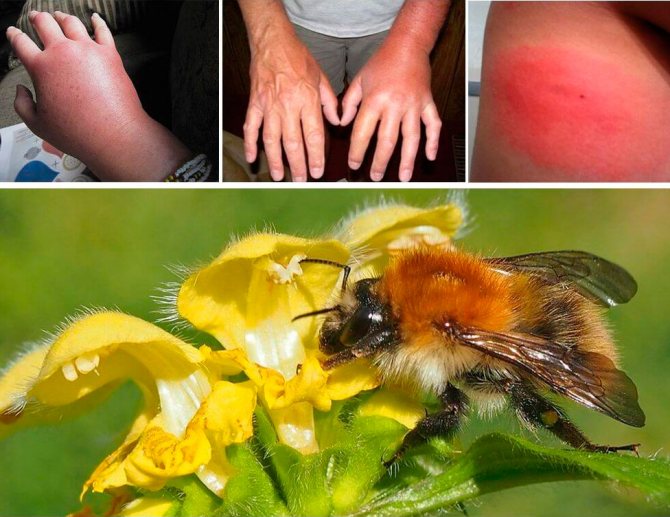

The body's response to an insect bite has nothing to do with whether the sting is left or not. Since bumblebees bite a person much less often than bees, few people know about the symptoms, and even more so about the consequences of a sting.
As a rule, the consequences of a bite are as follows:
- Severe pain appears.
- Unpleasant sensations as a result of itching and burning.
- There is swelling of the tissues and severe swelling with compaction of the bite site, as evidenced by the photo.
Similar symptoms appear immediately (a few seconds) after the bite. Negative manifestations (discomfort) lasts a certain time and depends on the characteristics of the organism of each person. This can take several days. If the bite site is constantly combed, the problem may worsen.
An allergic reaction also does not appear immediately, depending on how actively the body produces an antidote to bumblebee poison, which also poses a certain danger.
Allergic reactions are manifested in the following:
- The swelling and redness spreads to large areas of the body.
- A rash or large blisters appear on the skin.
- Nausea, vomiting and diarrhea may occur.
- The appearance of problems with breathing, with the onset of suffocation.
- The appearance of severe chills, against a background of high fever.
- Problems with the work of the cardiovascular system.
The possibility of anaphylactic shock onset, with the manifestation of dizziness, suffocation, convulsions, including fainting, is possible. In this case, it is better to immediately call an ambulance.
In the case of multiple bumblebee bites, you can observe:
- General weakness and dizziness.
- Nausea.
- Increased or slowed heart rate.
In what cases can you not do without a doctor?
A person can die as a result of an attack by a carpenter, garden, earthen and other types of bumblebees. A timely visit to a doctor will help prevent tragedy.
Medical assistance is needed in the following situations:
- bit a child, pregnant or lactating woman;
- the bite hit the neck, head, tongue, eyes;
- several bumblebees attacked at once;
- against the background of the bite, the person's body temperature increased, breathing was disturbed, chills, vomiting, convulsions, severe pain and rapidly increasing edema appeared.
Loading ...
First aid for a bite
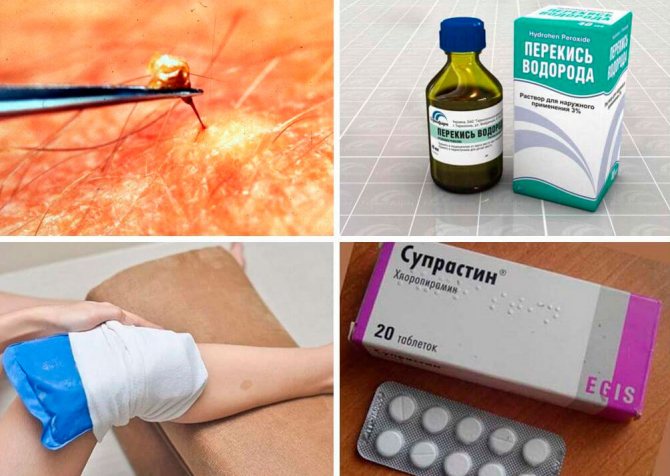

Many people are concerned about what can be done in the event of bumblebee bites to reduce the negative effects on the body. Adverse reactions are associated with a number of factors that can exacerbate negative reactions. For example:
- If a stinger is left behind, it must be pulled out immediately to reduce the risk of high toxicity.
- It is better to treat the bite site with an antiseptic, such as alcohol, hydrogen peroxide or a solution of potassium permanganate. All measures must be taken to reduce the risk of secondary infection.
- Alternatively, a cold compress can be applied to the bite site to help relieve pain and swelling.
- It is imperative to take an antihistamine to avoid an allergic reaction.This is especially true in relation to those people who are prone to allergies.
- You should increase your fluid intake in order to remove toxins from the body as quickly as possible.
- In case of deterioration in health, you should immediately call a medical specialist.
In case of an insect bite, it is unacceptable:
- You can not kill the insect, as this may attract the rest of the family.
- It is not recommended to scratch the bite site, as this can lead to re-infection.
- It is contraindicated to use sleeping pills or alcoholic beverages.
It's important to know! If you comb the bite site, the toxins begin to spread to neighboring areas. In the case of drinking alcoholic beverages, blood vessels begin to expand, which enhances the effect of toxins.
What to do if bitten by a bumblebee
An antihistamine will be able to help with a bumblebee bite. It is given even if there is no tendency to allergies. In case of hypersensitivity to beekeeping products, the agent is taken urgently in the maximum permissible dosage.
What should be done in the field? First, you can't panic. If anxiety and panic begins, then other bumblebees, who are probably nearby, may mistake this behavior of a stranger for aggression, which means that new bites will follow. Secondly, you should leave the dangerous place and find a place to lie down. If the female's sting breaks off, it is removed from the skin. The wound needs to be treated. You can anoint the bite site with any antiseptic, but it is better if it is not an alcohol-based drug - hydrogen peroxide, chlorhexidine, potassium permanganate solution.
Why is alcohol treated with caution? Ethanol accelerates the blood and increases the rate at which the poison is delivered. At the same time, the treatment itself increases the painful sensations. In order not to infect the wound, you can use a soda solution. To do this, you need to dissolve soda in a small amount of drinking water and lubricate the sting site. This procedure will reduce negative reactions to insect venom.
Treatment and pain relief for bites


Treatment of bite sites is carried out in various ways, using medications, as well as folk recipes. Therefore, to reduce discomfort, apply:
- Antiseptics, in the form of iodine, alcohol, hydrogen peroxide, Miromistin.
- Gels, in the form of "Fenistil", "Advantan", etc.
- Homeopathic remedies, in the form of "Apis Mellifik", "Urtica Urens", etc.
Bites are possible on the face, including the eyes. In such cases, the mucous membrane of the eye is washed with chilled strong tea. Alternatively, it is permissible to attach a freshly used tea bag.
Folk remedies based on natural ingredients will help reduce negative feelings and discomfort. For example:
- A compress made from freshly plucked plantain greens, parsley, dandelion leaves, etc. will help.
- A solution of baking soda, in the form of a mushy mixture, applied to the bite site will help relieve pain and itching.
- Alternatively, you can use a slice of raw potato, a slice of fresh cucumber, apple, or tomato.
- A mixture of vodka and freshly squeezed lemon juice can also help relieve pain and severe itching.
- Onions will help to cope with such a problem if you cut it and attach it to the problem area.
- Milk, frozen in cubes and applied to the bite site, will significantly reduce the discomfort.
- It is permissible to coat the bite site with chilled olive oil.
- A prepared mixture of 1 teaspoon of honey and 1 head of garlic has an antibacterial effect.
- An aloe leaf is taken, the skin is removed from one side and applied to the bite site.
- A mixture of a crushed tablet of activated carbon and validol dissolved in water will help relieve the level of redness and burning that is typical of the bite site.
Decoctions and infusions prepared on the basis of natural ingredients will help reduce the level of discomfort. For example:
- A decoction based on chamomile and calendula, which is used to wipe the bite site or used as a sedative drink, can relieve pain and reduce tissue swelling.
- Basil infusion. To do this, take 3 teaspoons of this plant and pour 1 glass of boiling water. After cooling, the infusion is taken in 1 tbsp. spoon 3 times a day as a sedative, and is also used for lotions.
- One tablespoon of calendula is infused in 200 grams of alcohol (70 percent) or moonshine for 3 days. After that, the infusion is diluted at the rate of 1 teaspoon per 50 ml of water. Lotions are made with this solution.
How to get rid of the effects of a sting
The main thing what to do if bitten by a bumblebee is to minimize the consequences. To do this, follow the recommendations:
- If the sting remains in the skin, carefully remove it with sterile devices (tweezers, forceps). Do not squeeze out!
- Wipe the damaged area with an antiseptic (hydrogen peroxide, potassium permanganate solution, vinegar or alcohol diluted with water).
- Apply something cold, especially if the bumblebee bite is on the sensitive part (cold will help relieve puffiness and prevent the spread of poison)
- You can draw out the poisonous substance with sugar or refined sugar soaked in water.
- Drink more liquid after the bite (especially warm strong sweet tea).
- For people with allergies, take an antihistamine.


Note! If the available means do not help, and the victim's condition only worsens, you must immediately go to the hospital!
Folk remedies for a bumblebee bite


Traditional medicine will help to quickly heal the wound. Effective recipes:
| Calcium | 35 mg | Potassium | 357 mg |
| Magnesium | 22 mg | Phosphorus | 26 mg |
| Sodium | 13 mg | Iron | 1.2 mg |
Localization of the bite and its treatment
The most common bite sites are the hand (when the person waves them off) and the leg (if the person accidentally stepped on the insect nest). If the victim is not allergic, the effects of the sting will go away quickly. They can be cured with folk remedies.
The most dangerous bite sites: the head and neck area (a bite can provoke swelling of the airways), lips and tongue (severe pain and swelling), face and eyes. In these cases, you must immediately consult a doctor.
If the bumblebee bite fell on the face and eyes, you can provide first aid before the arrival of the doctors:
- rinse the eye with strong cool tea or attach a tea bag. This will relieve swelling and have a soothing effect;
- apply a compress of potatoes: chop 1 fresh potato on a fine grater, apply on the eyelid with a cotton pad;
- make a lotion from a decoction of oak bark and herbs: 1 tsp. bark of oak, St. John's wort and mint pour 200 ml of boiled water. Wipe the affected area of the face with the composition;
- prepare a solution for edema: 1 tbsp. l. Pour salt with 1 cup of cool purified water. Moisten a cotton pad in the solution and apply to the bite site;
- drink an anti-inflammatory drink: grind 50 gr. parsley root, pour 500 ml of boiling water. Let it brew for 20 minutes, take orally.
When you need a doctor's help


In certain cases, it is necessary, without wasting a minute of precious time, to call an ambulance. For example:
- In case of multiple bites.
- In case of bites from children, pregnant women or people prone to allergies.
- When the bite site is near the eyes, near the mouth, or elsewhere on the face.
- In cases of rapid intoxication of the body, when the body does not have time to cope with toxins.
- In cases of infection of the wound, followed by suppuration.
Where are bumblebees found?
Bumblebees, like other nectar-collecting insects, are most often found where plants bloom. The forest, fields and meadows during flowering are the place where they store supplies for the whole family for the winter.Allergy sufferers should be careful at this time. When going out into the countryside or working in the field, you need to have antihistamines with you.
When walking in nature with children, you need to make sure that they do not accidentally touch the nest with bumblebees. Also, don't try to harvest wild bumblebee honey. It is worth remembering that bumblebees are peaceful insects, but they will defend their territory. If you behave in a civilized manner, do not do ill-considered actions, walks in nature do not threaten with bites.
How to prevent bumblebee bites
If bumblebees settled next to a person, then it is better to get rid of them and the sooner the better. To prevent bumblebees from being bitten, you should take precautions, which include a number of important rules, such as:
- It is undesirable to try to catch an insect, and also not to wave your hands or other objects near these insects.
- You should not be near the place where bumblebees accumulate or try to enter their nest.
- It is better to install mosquito nets in the house.
- It is better not to eat sweet food outside, which immediately attracts bees, wasps and bumblebees.
- When you are on vacation (in nature), you do not need to wear bright clothes, which attracts insects, and also do not use perfumes, which are distinguished by sharp, pronounced aromas.
By adhering to these simple recommendations, you will always be able to avoid the unpleasant consequences of insect bites. In any case, it is important to know what to do in the event that it was not possible to avoid a bite.
Prophylaxis
A bumblebee can sting you if you get close to his home and bring a lot of painful trouble. They rarely attack first, only if they sense a real danger. There are several ways you can avoid being bitten:
- Avoid bumblebee nests, there are many individuals, each female seeks to protect her child
- For picnics, walks, take along allergy medications, antiseptics
- It is best to choose clothes that are more closed so that the hornets have less space to bite.
- Keep a close watch on your children as they can safely come into contact with insects.
- Also, bumblebees often bite if people wave their hands next to them.
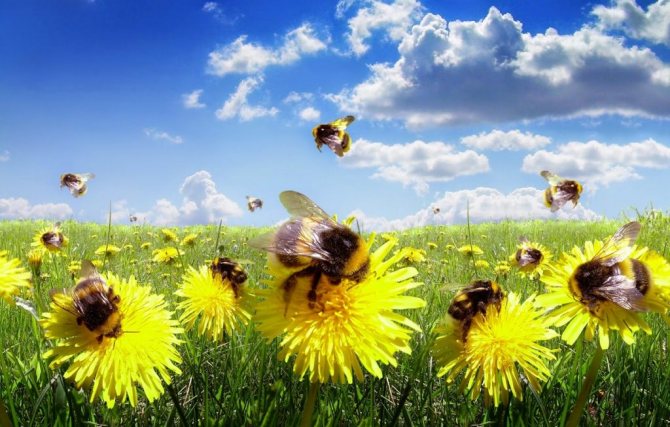

When going out into nature, be sure to ensure that you have a fully equipped first-aid kit, if you are bitten by a bumblebee, an allergic reaction begins, seek medical help immediately.
Bumblebees in brief
Bumblebee (Latin bombus) is a close relative of the well-known honey bee.
The genus is Hymenoptera, the family is real bees. Biologists have described about 40 subgenera and 300 species of bumblebees. Habitat - wildlife of northern Eurasia, North America, North Africa.
Bumblebees are highly organized insects. They live in families with a clear hierarchy: the queen, working females, male fertilizers, working individuals have builders and defenders of nests, pollen collectors, "educators" of larvae. The bumblebee colony numbers about 170 individuals, but it is difficult to find it: the settlement is carefully guarded.
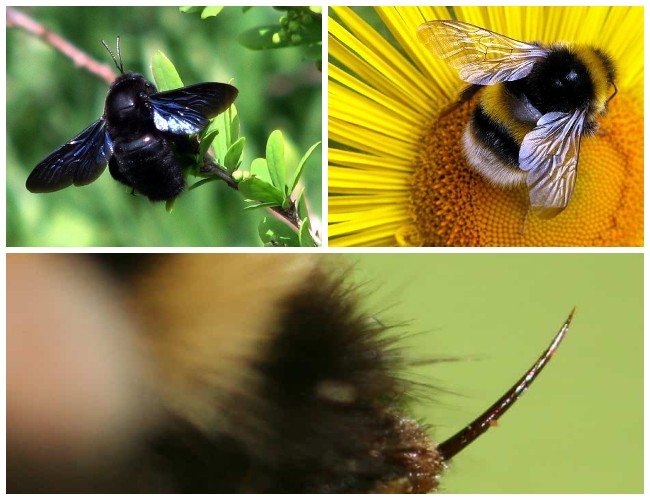

Biological features:
- in comparison with bees, wasps and hornets, the insect is large - the length of females is 12-32 mm, males - 8-25 mm (depending on the species);
- the color is yellow-black, there are black bumblebees and insects with yellow, orange stripes (which allows the insect to disguise itself as botanical parts of flowers);
- the wide body is densely covered with the smallest hairs, so that in the literature the bumblebee is rightly called “shaggy”;
- the insect has 6 legs, their tips are equipped with "baskets" for collecting and transferring pollen;
- flower nectar is the main food of the entire family, for the female larvae, honey is prepared from pollen (more liquid than bee honey, not so sweet and odorous);
- bumblebees sting with a sting; for defense and attack, the mouth apparatus is equipped with a pair of crossing mandibles.
For humans, the benefits of bumblebees are great, but the harm is minimal.Representatives of the bee family pollinate vegetable crops, garden trees, ornamental plants, increasing productivity at times. A side effect is the seeds of weeds on the site (bumblebees carry them on their shaggy paws along with pollen).
Interesting! In recent years, domestic bees have been dying en masse from herbicides and pesticides. In this regard, bumblebees are very hardy, so they are trying to domesticate these insects in agriculture. True, bumblebee honey plants are mediocre, but crop pollinators are excellent.

